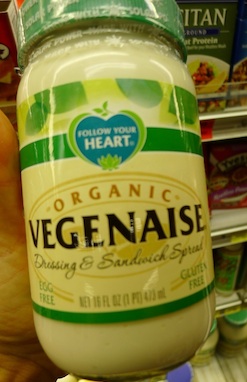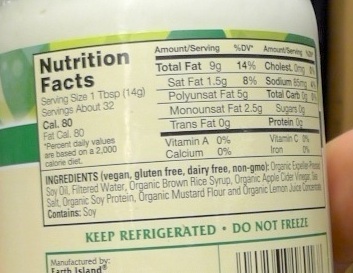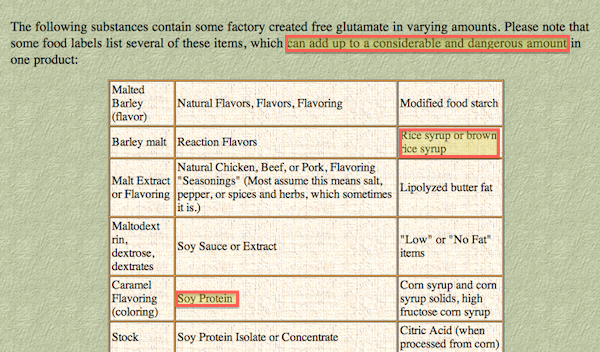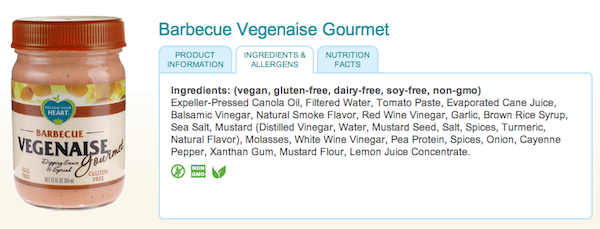What’s Wrong with Vegenaise

The only thing I would use is the glass jar, well cleaned of course
All information in this article is for educational purposes only.
It is not for the diagnosis, treatment, prescription or cure of any disease or health condition.
Here’s the problem with Vegenaise – it has hidden forms of MSG in disguise. “Oh, Jennifer…not again!” Well, I did say that I was sorry. What’s worse, Vegenaise recently got listed as “one of Ellen’s favorite things” on the Ellen Degeneres show. This makes me sick, because many people may try this product, not feel good and then think that a high raw food or vegan diet doesn’t work for them. They may go back to their old Standard American Diet (SAD) never to venture into the land of raw food and health again.
What is a “hidden form of MSG”?
Ok, here’s the deal. Food companies know that Monosodium Glutamate (MSG) is the best flavor enhancer there is; it is a food additive that adds A LOT of flavor to a product for little to no cost. BUT, savy consumers have caught on to MSG and most people know that it’s not a healthy additive because it can trigger migraine headaches, irritability, insomnia, rashes, hot flashes, dizziness, mood swings and even promote weight gain. A smart consumer like you will not buy a product containing MSG and the food companies know that. But they are already light years ahead of you! The food industry now uses new ingredients that contain what’s called factory created free glutamates. While one ingredient containing factory created free glutamates alone in a product may have a low concentrations of glutamate, using a combination of several ingredients together can add up to a considerable and dangerous amount of glutamate in one product, and in many cases you will actually find more glutamate than if the product had only contained MSG by itself! And that is why I called these ingredients MSG in disguise.

Never believe what you read on the front of a food product. Always read the list of ingredients before you decide to buy.
But keep reading. Do you see “brown rice syrup and soy protein?”
Not good. Not good at all! Actually I’m suspicious of the mustard flour too, I but can’t prove that one. (What is mustard flour anyway…shouldn’t it just read “mustard seed” or “ground whole mustard” if it is a natural ingredient?
Checking the list of hidden names for MSG, or monosodium glutamate, meaning ingredients that contain factory created free glutamates on msgmyth.com you will see:

Hidden Names for MSG from msgmyth.com
As a raw foodist but more importantly as a person who eats only natural, whole and pure foods, I would not eat Vegenaise, knowingly. And the reason why I say that is because I’ve seen Vegenaise as an added ingredient in salad bars at health food stores in the USA (and also in Hong Kong). If you don’t look carefully, you could easily be eating a fresh, raw salad with all the organic bells and whistles and find yourself with a headache later, restless sleep through the night and a cranky irritable ‘snappy’ nature and maybe even a puffy face the next day. You might even find yourself itching your scalp, your eyes or your leg and meanwhile have no idea whatsoever that the cause of your discomfort was from that Vegenaise. Too many times, people swear to me that they only eat organic and they never eat MSG, Disodium Inosinate, Ribonucleotide, or Disodium Guanylate (which can be legally hidden in the other ingredients like “onion powder” or “natural flavors”).
Time to take the organic wool off the non-GMO eyes and understand what and how these chemical additives can affect you, your health and the health of your family.
My advice: Do NOT use Vegenaise. Ever. Check all salad bar ingredients before choosing to buy. If you don’t know or if it isn’t listed, ask. If the staff member seems unsure or can’t provide a clear, concise list of ingredients, then please don’t take the chance.
I have found high glutamate-content ingredients aka hidden MSG in 99.9% of the restaurants I’ve been to, and that includes vegan, gluten-free, non-GMO, organic and raw food restaurants.
Chefs are simply not educated to the level of hidden names for chemical food additives. I even had a certified raw food chef tell me recently that they were giving their newborn baby soy formula (something that is known and proven to have hidden MSG in the form of Organic Brown Rice Syrup, Organic Soy Protein Concentrate. Yes, you should be familiar with those offenders by now!). Giving high glutamate-content foods (even more concentrated in liquid form than in solid foods) to a newborn baby is a sure way to have many, many sleepless nights. If a certified raw food chef doesn’t know to avoid those for their own child, do you think they will know how to make a ‘safe’ salad by checking all ingredients on all sauces, dressings and spice mixtures? Do you think they will know what to ask the supplier?
Please don’t think you’re doing yourself a favor by choosing the soy-free version of Vegenaise. You will still find Brown Rice Syrup and Pea Protein, just as bad! It’s like choosing cocaine instead of crack….you won’t get any halo for that upgrade!
Their Horseradish Sauce: Brown Rice Syrup Pea Protein, Natural Flavor.
Tartar Sauce: Brown Rice Syrup, Pea Protein.
Roasted Garlic Vegenaise Gourmet: Brown Rice Syrup, Pea Protein, Natural Flavor.
Barbecue Vegenaise Gourmet: Seriously? Natural Smoke Flavor, Red Brown Rice Syrup, Spices, Natural Flavor, Pea Protein.
Chipotle Vegenaise Gourmet: Brown Rice Syrup, Pea Protein, Chipotle Powder, Natural Smoke Flavor, Natural Flavor, Paprika Extract.
Pesto Vegenaise Gourmet: Brown Rice Syrup, Pea Protein.

I couldn’t make this stuff up if I tried!
Are you starting to see a pattern here? Your body is an organic being and it’s sensitive to chemical derivatives and extracts. These ‘crack’ food additives add a lot of flavor to food making it additive, savory and yummy, but they also over-stimulate your brain. And your central nervous system. And that is not a good thing! High glutamate ingredients also over-stimulate your appetite, making your hungrier hours later and even into the next day. In lab studies, the common protocol to make a rat gain weight is to give it Monosodium Glutamate (MSG). Do you want to be a food industry rat? I certainly don’t!
You only use their salad dressings? Well, let’s check them out:
Vegan Honey Mustard: Brown Rice Syrup, Non-GMO Soy Protein, Natural Flavors, Spices. (I love how they put the Non-GMO…it’s like saying, ‘Hey, I have some crack to sell you…but don’t worry…it’s Non-GMO and organic!’)
Vegan Sesame Dijon: Brown Rice Syrup, Natural Flavors.
Vegan Thousand Island: Brown Rice Syrup, Non-GMO Soy Protein, Spices.
Organic Miso Ginger: Brown Rice Syrup, Non-GMO Soy Protein.
Spicey Southwestern Ranch: Brown Rice Syrup, Non-GMO Soy Protein, Brown Rice Syrup (again), Vegetable Enzyme, Vegetable Enzyme (again), Spices.

Make your own healthy version with:
Raw apple cider vinegar, shredded fresh raw ginger, fresh lemon, fresh garlic and water. Easy!
There’s something to be said for using all pure, natural whole ingredients and for feeding your body foods that boost your health and immune system. It’s not hard to make your own salad dressings and sauces at home, and actually it’s cheaper too. I don’t advocate the non-vegan version of these sauces either…they are full of the same added ingredients! What I advocate is REAL FOOD. A dressing made with fresh lemon, fresh garlic, cayenne pepper, cumin and fresh parsley, as an example. Isn’t it time to make the change, throw out these inferior foods and start giving your body what it deserves?
If you think you have reacted to a food which is either not labeled correctly or is label suspiciously, you have every right to contact the company by email and ask what’s in their food.
You can do this in every country in the world, even as an ex-pat living in a foreign country. I suggest that you word your email in this way:
“I recently ate your xyz product and x hours later I experienced the following reaction: (describe symptoms here). I have discussed this with my doctor and he/she has informed me that I need to know for medical reasons all of the ingredients that was in the food. Specifically, I need to know if you use MSG (Monosodium Glutamate), Ribonucleotide, Disodium Inosinate or Disodium Guanylate in any of the ingredients that you use to make your product. Also, I need to know how much factory created free glutamate is in the following ingredients (list suspicious ingredients like pea protein, yeast extract, malodextrin, soy protein, natural flavorings, etc here). Thank you and I appreciate you taking the time to respond to my inquiry.”
I do NOT suggest that you write any emails like this: “Jennifer said blah blah blah blah and Jennifer’s blog post says blah blah blah so what do you have to say about that?!” Please, be professional and courteous if you are writing an inquiry to a company. You have to ask the right questions to get the right answers. These companies have legal teams that know how to respond and get through hoops if you do not ask the right questions. My goal is that every product be required to label their total factory created glutamate concentration and any hidden ingredients or flavor enhancers so ultimately, you can make the best choice of food for you!







For more on how to start an additive-free diet diet, how to manage food allergies or what minerals you may specifically be deficient in, book a private health consult with me via Skype.
How to Book Your Health & Nutritional Coaching Session:
1. Take photos of your eyes with a digital camera.
2. Email the photos to me for approval.
3. We schedule a time to meet via phone or Skype!
More on Food Additives:
- Sea Salt with Chemical Additives?! Check for E535 & E536 Yellow Prussiate of Soda (YPS)
- Why I don’t add Almond Milk, Soy Milk or Coconut Water to Green Smoothies
- The Truth in Food Labeling – Food Additives to Avoid & Hidden Sources of MSG
- Food Containing Ribonucleotides – The Ribo Rash from Food Additives 635, 627 and 631
- Hidden Sources of MSG on Food Labels: Video Guide

Follow Jennifer